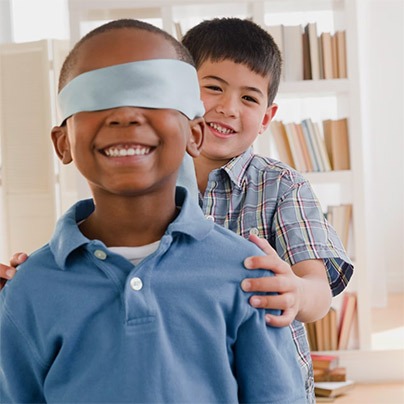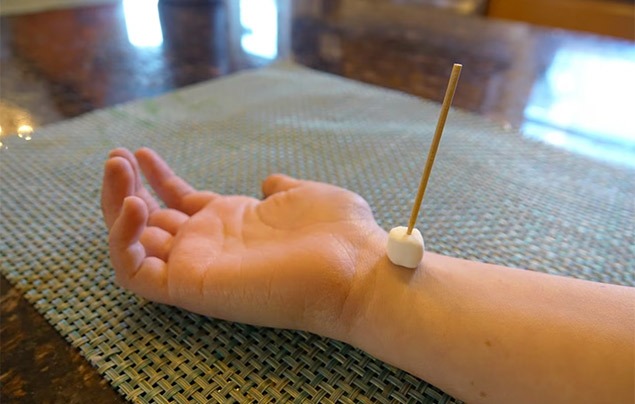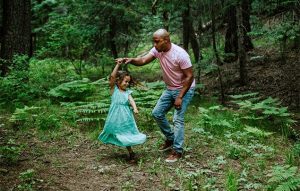Five easy science experiments to do at home
Check out these speedy STEM activities that kids can do on themselves!
Kids won’t need beakers and microscopes for these easy science experiments to do at home – they just need themselves!
Each of these five biology activities lets children discover how a human body system works. And by doing these ‘tests’ on their own bodies, they’ll get to see and feel exactly how their own systems function. (We promise it’s safe!)
“Going through the process of physically doing something gets people more excited than just reading about it or watching someone else do it,” says Evan Barnes, a biology instructor at Westmont College in California.
Challenge your kids to experiment on themselves with these activities – and watch them be wowed.
1. The Big Jump (muscular system)
What to do: Have your kids stand with their legs straight and try to jump. Then have them bend their knees and jump again. This time they’ll probably be more successful!
What’s going on: The muscular system is made of special cells called muscle fibres that contract to help your body move. “As you crouch, the muscle fibres in your thighs, hips and glutes contract,” MacKenzie says. “When you start to jump, the muscle fibres expand, and the effect is like a spring uncoiling.” That releases the energy needed for your body to jump. When your legs are straight, the muscles don’t contract, so they don’t release as much energy.
2. Spinning and Sitting (nervous system)
What to do: Have your child sit in a chair blindfolded, then stand up and spin in a circle seven times. Now, without removing the blindfold, have them try to find the seat to sit down. (Make sure you do this in a safe place that’s clear of obstacles!)
What’s going on: The nervous system relies on chemical and electrical signals to communicate with the brain and different parts of the body. Those signals are sent with the help of receptors that are all over your body – including hair-like structures in the inner ear. When those receptors are touched by the endolymph, a fluid inside the ear’s canals, they send a message to the brain that your body is moving. But after you stop spinning, the fluid keeps moving.
“That sends signals to the brain, brain stem and cerebellum, and the brain interprets this as movement,” says biology instructor Jamie Parker of Fordham University in New York City. “So, if the liquid is moving while you’re still, your brain still thinks you’re still spinning.”
Get more fun family activities straight to your inbox with Nat Geo Kids’ free newsletter. Sign up here!
3. Water Bottle Test (respiratory system)
What to do: Fill an empty water bottle with water and dump it into a large basin. (Tip: Do this in the sink!) Refill the bottle, mark the water level on the outside and place the cap back. Turn the bottle upside down into the basin. Then, keeping the mouth of the bottle underwater, take off the cap. Have your child insert a bendy straw into the jug, with the other end sticking out of the water.
Have your kid take a deep breath, then blow into the straw until no more air is in their lungs. When they’ve blown out all they can, place the cap back on the still-underwater jug. When you remove it from the water, you’ll see the water level has gone down, and the missing water replaced by air.
What’s going on: Our lungs breathe in oxygen that our cells need to live, then breathe out carbon dioxide as a waste product. The air in the bottle shows how much carbon dioxide they’ve exhaled – and how much lung capacity they have to inhale air.
4. Hopping Marshmallow (circulatory system)
What to do: Have a child stick a marshmallow on top of a toothpick. (A mini one is best, but any will do!) With their arm palm-up on a level surface, balance the marshmallow so that the toothpick sticks straight up over their wrist where they feel a pulse. You’ll see the marshmallow stick jiggle back and forth or even hop up and down. Then have your kid jog or do star jumps for 30 seconds, and repeat. The marshmallow stick will move faster!
What’s going on: The circulatory system is what causes the heart to pump blood and lymph through your body’s arteries and veins. Pumping blood into an artery creates a pulse. That’s what you feel when you press your fingertips to your wrist—and why the marshmallow stick moves when it’s balanced there. And after you exercise? “The heart pumps more strongly to send more blood to the areas of the body that are moving, bringing them more nutrients and oxygen,” Parker says.
5. Bag of Bones (skeletal system)
What to do: Grab a friend for this experiment! With a long string, Kid 1 measures the height of Kid 2, then cuts the string there. Then Kid 2 stretches their arms out to each side, and Kid 1 uses the same string to measure fingertip to fingertip. It will be almost exactly the same length!
Now fold the string in half, and measure from the bottom of the heel to the top of the femur (just under the rear end). It will be almost exactly half the distance from fingertip to fingertip. If you unfold the same string and then fold it in half twice, it will equal the distance from the elbow to the fingertip. Finally, unfold the string and refold it in thirds, and it will equal the circumference of the head!
What’s going on: The skeletal system is all about the body’s bones and how the muscles support them, helping us stand and walk. So, your skeleton’s limbs must be proportionate to each other. “If these proportions are uneven, it will impact your gait,” MacKenzie says. If your legs are uneven, you might limp. Or, if your arms are too long for your legs or your skull is too big for your spine, you might have trouble balancing.














LEAVE A COMMENT
THANK YOU
Your comment will be checked and approved shortly.
WELL DONE,
YOUR COMMENT
HAS BEEN ADDED!
COMMENTS
CUSTOMIZE YOUR AVATAR